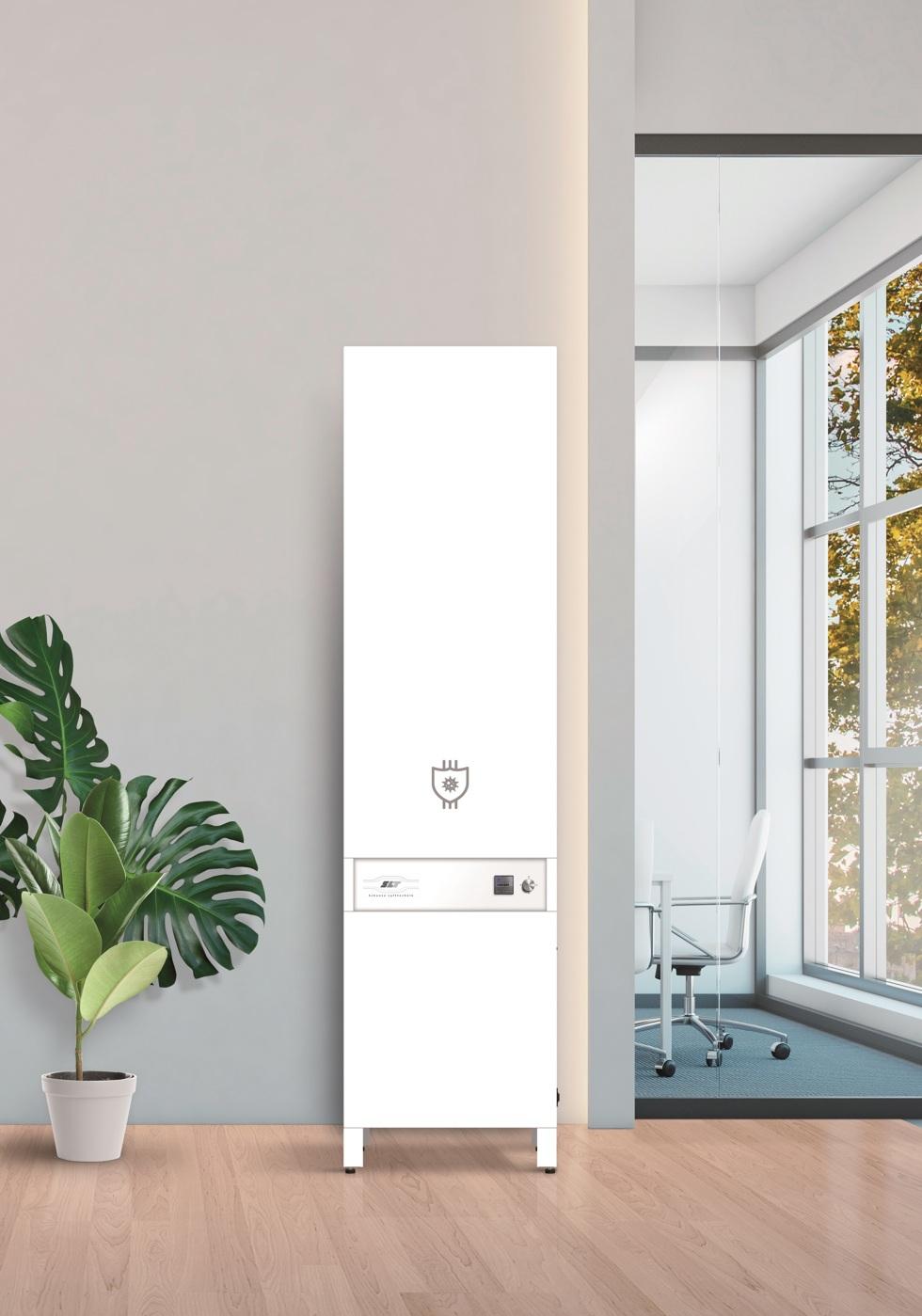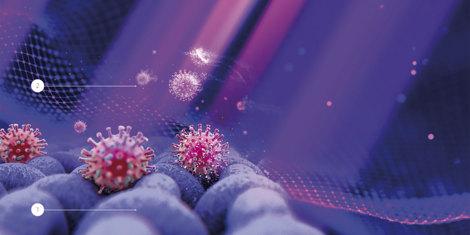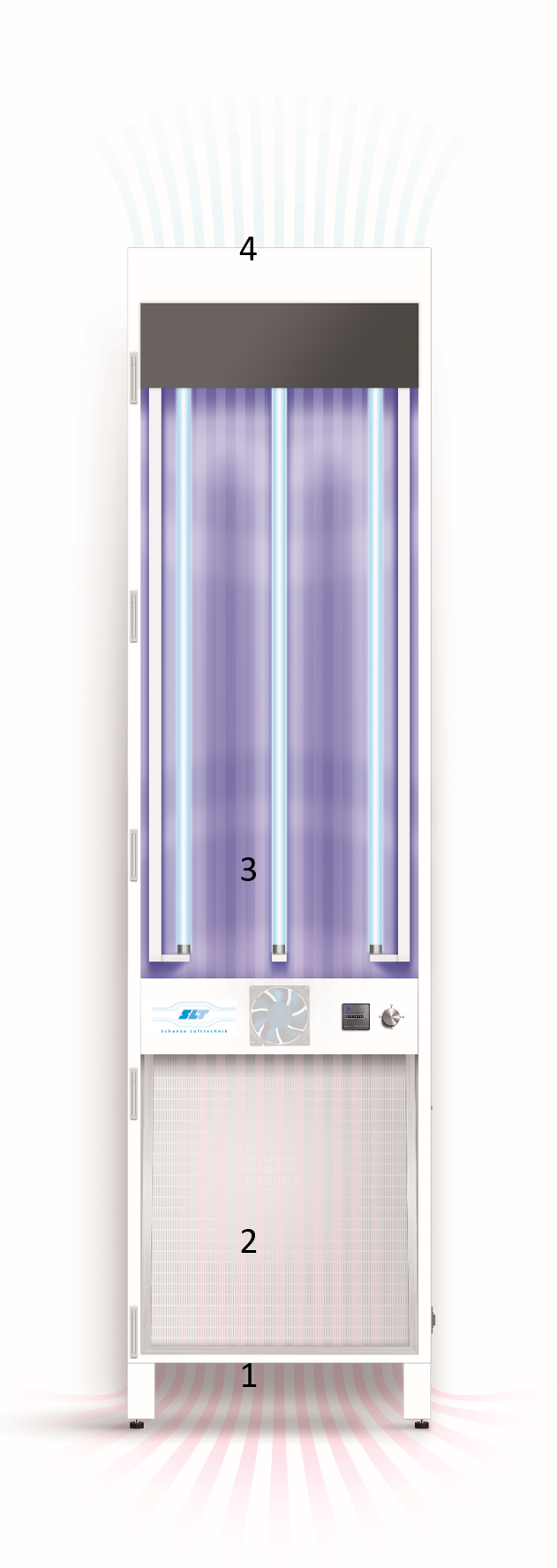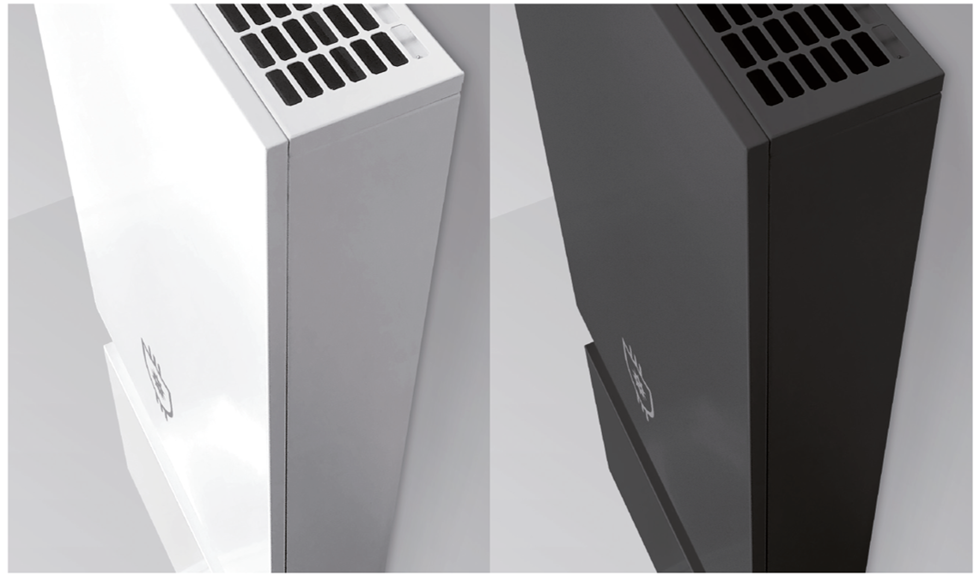UV-C AIR CLEANER
UV-C air sterilizer unit for indoor applications
The air sterilizer from SLT offers an effective solution for elemination of airborne viruses.

Ultraviolet-C radiation
The mechanism of disinfection is based on ultraviolet radiation: UV-C radiation is electromagnetic radiation in the range of 200–280 nanometers, which is smaller than visible light but has a longer wavelength than X-rays. This radiation has a germicidal effect: microorganisms (viruses, bacteria, molds) exposed to UV-C light become inactive in seconds.

The optimal wavelength of UV-C radiation for maximum sterilizing effect is 264 nm.

1. The unit performs mechanical separation in the first phase of the operation: the efficient (type M6) air filter removes the majority of solid contaminants.
2. In the second phase, the UV-C radiation kills the pathogens that have passed through the filter.
Airborne viruses
In the case of Covid-19, airborne infection has been clearly confirmed. Pathogens can not only be transferred by large water droplets formed during coughing and sneezing, but also by fine vapor released into the air during
exhalation. One of the main characteristics of aerosol - containing fine particles - is that it remains floating in the air for several hours. Therefore, it is recommended for everyone to wear a mask.
A way to partially prevent airborne viruses entering our bodies is to wear excellent quality masks which are usually not only very expensive but also uncomfortable. Furthermore, it has been shown that infections can also enter the human body through the eyes, not just the mouth and nose.
It is evident that decreasing the number of pathogens in the air could significantly improve the situation.
UV-C disinfecting
The UV-C air sterilizer unit offers a simple and effective solution for the elimination of airborne viruses. The unit performs mechanical separation in the first phase of the operation: the air filter removes solid contaminants, and in the second phase, the UV-C radiation kills the pathogens that have passed through the filter. UV-C radiation is within the short wave length range of natural light. When applied correctly it acts as a safe and highly efficient disinfectant as the short wave length ultra violet radiation of 253,7 nm damages the pathogens DNA thus prevents them from infecting any further. The bacteria, viruses and fungi spores exposed to UV-C light die, however inactivating various pathogens requires different doses of UV-C light. By applying the right UV-C light source a sterilizing rate of 99,99% can be reached.
Other effects of UV-C radiation
There is no ozone formation: short wavelength UV-C radiation (180-200 nm) transforms the oxygen of the air into ozone, which, although above a certain level of concentration is toxic, can be useful in small doses which is why it is often used in deodorant appliances. The UV-C Air Cleaner’s fluorescent tubes emit light between wavelengths of 260-280 nm, as a result the possibility of ozone formation is zero.
Effects on health: UV-C radiation damages the skin and can cause blindness. Thanks to the design - locked cabinet - the UV-C rays remain inside the unit and the human body is not directly exposed.
The efficiency of the UV-C Air Cleaner device has been tested under laboratory conditions. The tests showed that by circulating the air of the room just once the device kills almost all (99,99%) of airborne bacterial and viral pathogens examined1. Using decades of experience in ventilation, designing and manufacturing, the first prototypes were perfected and are now ready for serial production so we can help in the fight against COVID-19. The device can help increase the protection of those most exposed to the infection in the current virus situation. Furthermore, once the crisis is over, it can help other prevent potential airborne infections. Considering that it is equally effective in filtering out airborne allergens, its use can help relieve the symptoms of allergies too.
1 Texas Research International Inc. Laboratory Test Report: Bioaerosol Removal Efficiency. (1993. oct. 8.)
Product features
Thanks to its special design:
- Requires minimum space.
- The aesthetically pleasing apperance allows it to blend into any enviroment.
- By circulating the room‘s air, it effeciently sterilizes it
- Operates silently thanks to the eneregy-efficient EC fans.
- Easy to undertake maintenance work on it.
- The cover is easy to clean - painted with epoxy powder coating (C4 corrosion class).
Advantages
Some of the advantages of the SLT UV-C Air Cleaner:
- The unit can inactivate the pathogens that have passed through the filter. The process does not create byproducts.
- Due to the efficient filtering and UV-C radiation, the cleaned air leaving the unit is practically free of pathogens.
- Unlike other UV-C emitters (used in medical environments), which do not allow people to stay in the room during use, the UV-C Air sterilizer is optically closed which makes it possible to use in doctors‘ offices, waiting
- rooms, hospital patient rooms.
- Creates favourable air movements, pushing the airborne particles down ward and continuously circulating and cleaning the room‘s air without creating whirls.
Operation
The unit works as follows (from bottom to top):

1. The air is drawn into the unit at the bottom due to the EC fans.
2. The air then goes through the filter which removes the majority of airborne particles from the air.
3. The UV reactor sterilizes even the smallest remaining particles with UV-C radiation.
4. The sterilized air then enters back into the room through the top of the unit.
Air movement
CFD simulation of the air movement generated by the UV-C Air Cleaner.

Types

The UV-C Air Cleaner painted to white or anthracite colors.
